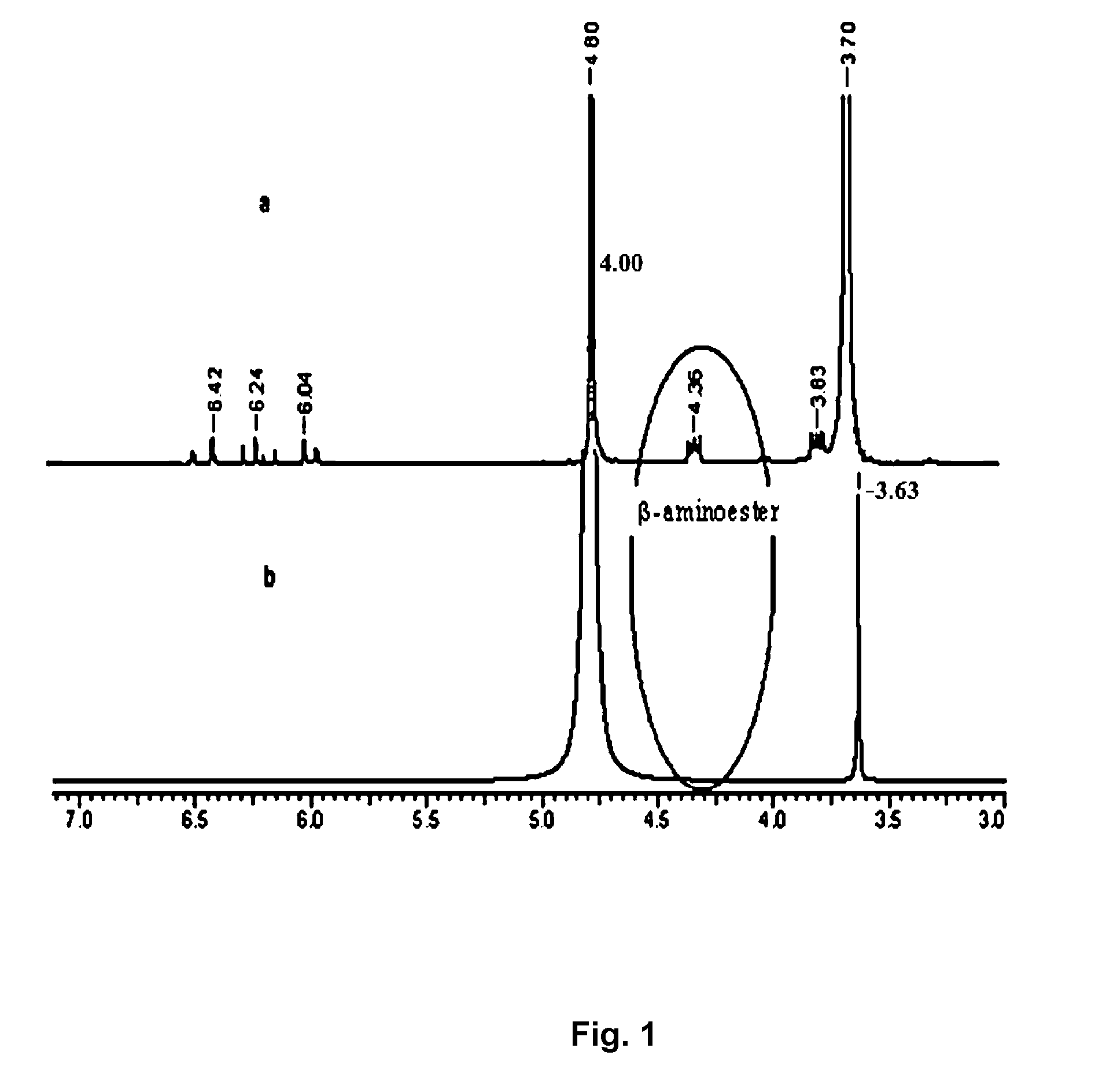Biodegradable Polymeric Hydrogel Composition
- Summary
- Abstract
- Description
- Claims
- Application Information
AI Technical Summary
Benefits of technology
Problems solved by technology
Method used
Image
Examples
example 1
Synthesis of Hydrogel from Amine Modified Poly(Ethylene Glycol)Diacrylate and Polyethylene Glycol)Diacrylate (PEGDA) (Mn=700)
[0076]Amine modified poly(ethylene glycol)diacrylate (PEGDADA)
[0077]End modified poly(ethylene glycol)diacrylate (Mn=700) was synthesized by reacting PEGDA with excess of ethylenediamine. 5 g of PEGDA in 10 ml dichloromethane (DCM) was added to a solution of 7 ml ethylenediamine in 10 ml dichloromethane with stirring. After complete addition the mixture was stirred using magnetic stirrer over 12 hrs at 25° C. The solution was poured into a mixture of diethylether / ethanol (90 / 10) to obtain viscous amine capped PEGDA (PEGDADA). The macromer was stored at 5° C.
Hydrogel Preparation
[0078]0.039 g of amine modified polyethylene glycol diacrylate (PEGDADA) dissolved in 100 μl of phosphate buffer at pH 7.4 was mixed with 0.100 g of PEGDA (Mn=700). The mixture was incubated at 37° C. in a water bath to form hydrogel. The gel time, water content and hydrogel degradation ...
example 2
Synthesis of Hydrogel from Amine Modified Poly(Ethylene Glycol)Diacrylate and Polyethylene Glycol)Diacrylate (PEGDA) (Mn=258)
[0079]0.105 g of amine modified poly(ethylene glycol)diacrylate dissolved in 100 μl of phosphate buffer at pH 7.4 was mixed with 0.100 g of PEGDA (Mn=258). The mixture was incubated at 37° C. in a water bath to form hydrogel. The gel time, water content and hydrogel degradation time are described in Table 1.
example 3
Synthesis of hydrogel from poly(amino ester)s (1,4-butanediol diacrylate and 1-(2-aminoethyl)piperazine) and Poly(ethylene glycol)diacrylate (PEGDA) (Mn=700)
Synthesis of poly(amino ester)s from 1,4-butanediol diacrylate and 1-(2-aminoethyl)piperazine (PAEPBDDA)
[0080]2 g of 1,4-butanediol diacrylate in 20 ml of chloroform was added dropwise to a solution of 1.3035 g of 1-(2-aminoethyl)piperazine in 15 ml of chloroform under stirring at 25° C. for a period of one hour. After completion of addition, the reaction temperature was increased to 45° C. The reaction mixture was stirred at 45° C. for 3 days. The solution was concentrated and precipitated in diethylether to obtain a water soluble poly(amino ester). The molecular weight of the polymer was determined by Vapour Pressure Osmometry and is summarized in Table 2.
Hydrogel Preparation
[0081]0.100 g of PAEPBDDA dissolved in 200 μl of phosphate buffer at pH 7.4 was mixed with 0.107 g of PEGDA. The mixture was incubated at 37° C. in a wate...
PUM
| Property | Measurement | Unit |
|---|---|---|
| Temperature | aaaaa | aaaaa |
| Temperature | aaaaa | aaaaa |
| Temperature | aaaaa | aaaaa |
Abstract
Description
Claims
Application Information
 Login to View More
Login to View More - R&D Engineer
- R&D Manager
- IP Professional
- Industry Leading Data Capabilities
- Powerful AI technology
- Patent DNA Extraction
Browse by: Latest US Patents, China's latest patents, Technical Efficacy Thesaurus, Application Domain, Technology Topic, Popular Technical Reports.
© 2024 PatSnap. All rights reserved.Legal|Privacy policy|Modern Slavery Act Transparency Statement|Sitemap|About US| Contact US: help@patsnap.com









